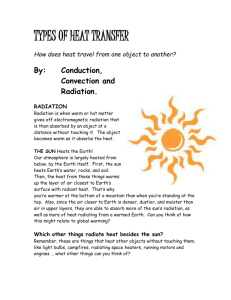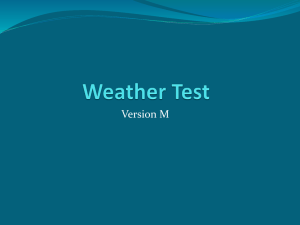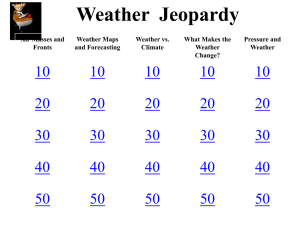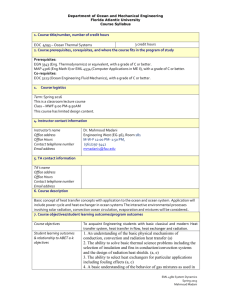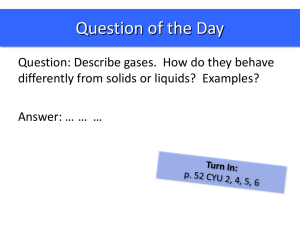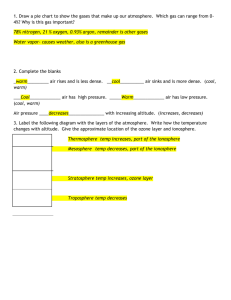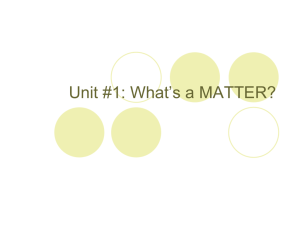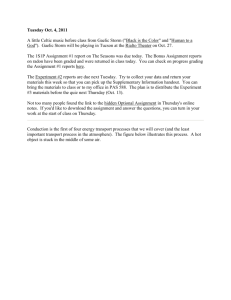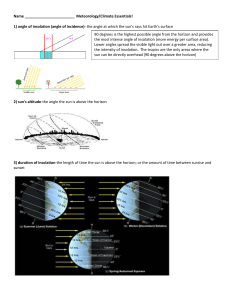Semester 1 Exam Study Guide Answers complete
advertisement
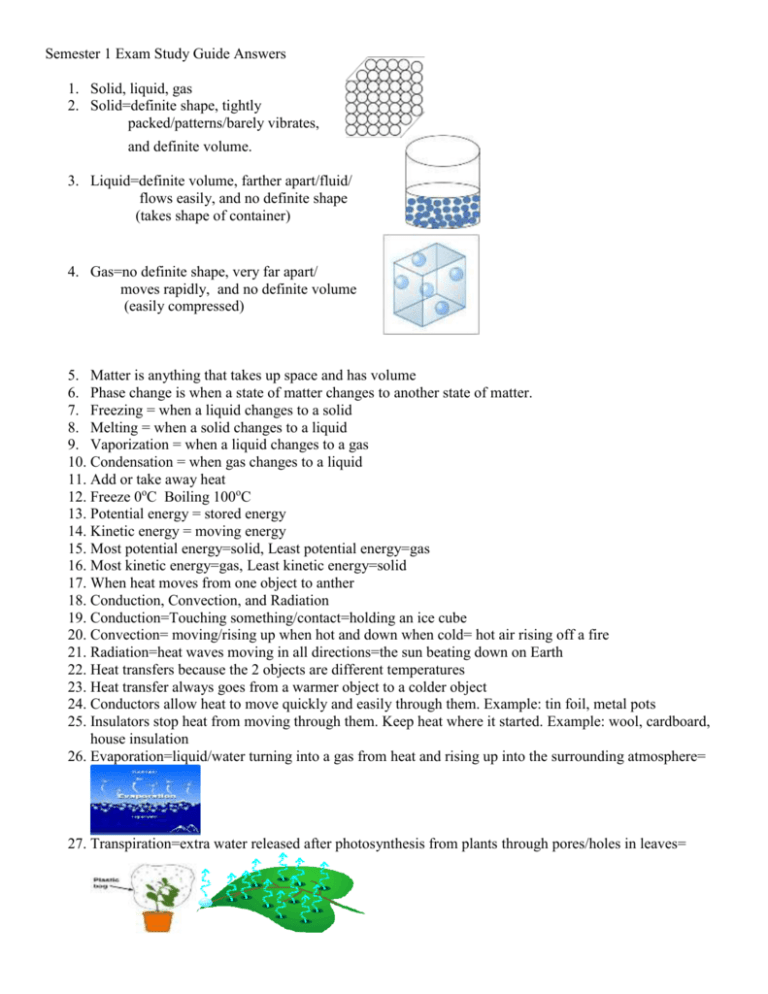
Semester 1 Exam Study Guide Answers 1. Solid, liquid, gas 2. Solid=definite shape, tightly packed/patterns/barely vibrates, and definite volume. 3. Liquid=definite volume, farther apart/fluid/ flows easily, and no definite shape (takes shape of container) 4. Gas=no definite shape, very far apart/ moves rapidly, and no definite volume (easily compressed) 5. Matter is anything that takes up space and has volume 6. Phase change is when a state of matter changes to another state of matter. 7. Freezing = when a liquid changes to a solid 8. Melting = when a solid changes to a liquid 9. Vaporization = when a liquid changes to a gas 10. Condensation = when gas changes to a liquid 11. Add or take away heat 12. Freeze 0oC Boiling 100oC 13. Potential energy = stored energy 14. Kinetic energy = moving energy 15. Most potential energy=solid, Least potential energy=gas 16. Most kinetic energy=gas, Least kinetic energy=solid 17. When heat moves from one object to anther 18. Conduction, Convection, and Radiation 19. Conduction=Touching something/contact=holding an ice cube 20. Convection= moving/rising up when hot and down when cold= hot air rising off a fire 21. Radiation=heat waves moving in all directions=the sun beating down on Earth 22. Heat transfers because the 2 objects are different temperatures 23. Heat transfer always goes from a warmer object to a colder object 24. Conductors allow heat to move quickly and easily through them. Example: tin foil, metal pots 25. Insulators stop heat from moving through them. Keep heat where it started. Example: wool, cardboard, house insulation 26. Evaporation=liquid/water turning into a gas from heat and rising up into the surrounding atmosphere= 27. Transpiration=extra water released after photosynthesis from plants through pores/holes in leaves= 28. Infiltration= runoff water that seeps/trickles down into the surface of the soil= 29. Condensation=gas/water vapor that turns into a liquid, as it cools it changes state= 30. Precipitation and infiltration/runoff depend on gravity to move water in the water cycle. 31. The matter in a cloud can be in a solid, liquid, or gas state (evaporation/condensation). 32. Most of the energy that drives the water cycle comes from the sun (heat/radiation or absence of). 33. Air masses are large volumes of air with mostly the same temperature and humidity (influenced by location on Earth). 34. Las Vegas air mass movement is mT (maritime Tropical=influenced by the ocean, producing warm/dry temps) 35. H on a weather map=high pressure, usually happy weather (calm, bright/sunny, dry) 36. L on a weather map=low pressure, usually lousy weather (windy, wet/rainy/stormy) 37. Meteorology is the study of Earth’s atmosphere, temperature and moisture changes that produces weather. 38. A front shows the boundaries between air masses with one air mass replacing the other (temperature, humidity and wind changes). Types of fronts=cold, warm, stationary, occluded 39. Warm front=shown by line with half circles pointing in direction air is moving on weather map Warm air mass takes the place of the cold air mass (produces warmer temperatures) Cold front= shown by a line with triangles pointing in the direction that the air is moving Cold air mass takes the place of a warm air mass (produces colder temperatures) 40. Plans=outside day-warm front, inside day-cold front 41. H=sunny and bright, L=rainy and cloudy 42. 3 bodies of water that influence weather in the USA- Pacific Ocean, Atlantic Ocean, Gulf of Mexico 43. NY/East Coast-Atlantic Ocean CA/West Coat-Pacific Ocean TX/Southern States- Gulf of Mexico Constructed Response-Water Cycle Review: 1. condensation, evaporation, groundwater (infiltration), runoff, precipitation, transpiration, solar radiation) 2. Influenced by gravity-infiltration/runoff and precipitation 3. Runoff-flows across, down, or over the surface of the Earth from higher to lower elevation 4. Infiltration-seeps/percolates into or through the soil, can accumulate into an underground aquifer 5. Gravity exerts force on the water to pull it down toward the surface of the Earth (higher to lower area) Constructed Response Heat Transfer Review: 1. 2. 3. 4. 5. Heat Transfer: transfer of heat from a warmer to a cooler object (warm hands melt colder ice) Heat can/will continue to transfer until the 2 objects are equal temperature. 3 types of heat transfer: conduction, convection, and radiation Radiation-heat waves/rays traveling through the atmosphere from the hot object to the cooler object Conduction-heat that transfers by direct touch or contact from the hot to the cooler object Conductors allow heat to transfer easily (some metals). Insulators do not allow heat transfer easily (plastic). 6. Be able to make a claim for each one, support it with evidence from the picture provided, and give scientific reasoning to further support the claim (I know this is the right answer, because this is the science behind it).
